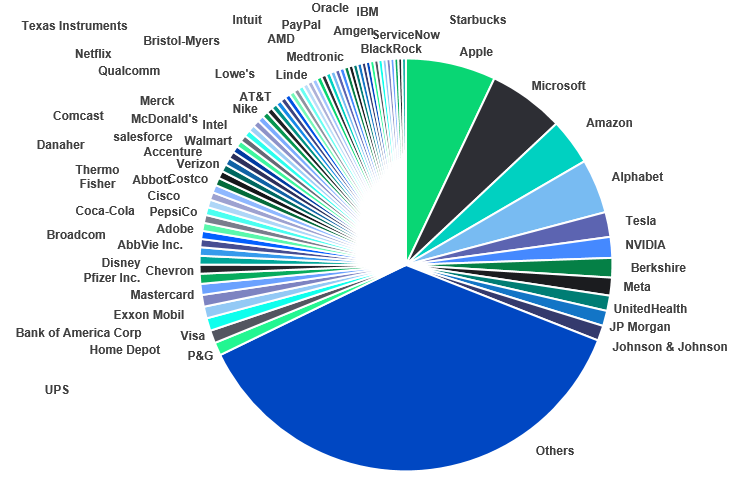Leading brands tend to be more resilient and stand the test of time. Why brands matter, how to gain exposure, and what pitfalls to avoid?
The world is constantly evolving, with consumer trends and preferences changing quickly. Digital transformation is allowing household names to modernise and increasingly pivot their business models to key growth areas. The leading brands can utilise their branding power, that comes with a good reputation and other key attributes, to quickly move into new markets with high potential.
Why brands matter
Brands tell a story, give consumers aspirations, develop loyalty, and often enable companies to harness a competitive advantage that comes with substantial pricing power.
Strong brands have a magical twist that often brings comfort to long-term shareholders:
- Reputation: Brand reputation is the way the company is viewed by customers and what they associate to the brand. Some brands trigger particularly positive emotions. For example, drinking a Coca-Cola may be a moment of relaxation for some, while Lamborghinis may bring an emotion of achievement or of chasing the next thrill.
- Values: Some brands, particularly in luxury, allow consumers to make a statement about themselves, which allows substantial premiums, having strong pricing power. For example, luxury watch maker Patek Philippe is famous for its slogan introduced in 1996: “You never actually own a Patek Philippe. You merely look after it for the next generation”.
- Brand leadership: Often translates to sales growth, margin expansion, pricing power, distributor and channel power, negotiation advantage with suppliers, employee recruitment etc. Examples include Lululemon, the leader in premium yoga wear, built a community, Tesla, the leader in electric vehicles,with Elon Musk.
- Differentiation: Key drivers of strong brand are the ability of a company to innovate, develop its IP, and have proximity to its users. For example, Coca-Cola not only has a good IP through its unique recipe, but it also relies on an incredible marketing team that drives engagement with consumers. Brands spend a lot of resources to stay relevant.
- Advertising: Big brands have mastered advertising, branding, storytelling. For example, Nike was able to connect with its customers through its ‘Just Do It’ campaign in 1988, which featured professional and amateur athletes talking about their accomplishments and the emotions they feel when exercising.
- Optionality: Established brands often cultivate fans through trust. The company often can leverage its brand to branch out into other areas. For example, once the streaming market was well established, Disney developed its own streaming service, directly competing with Netflix. Similarly, designer brands of luxury bags leverage their brands to sell everyday wear, but at a premium price. More recently, Ferrari CEO said to explore ways to enter NFTs, metaverse, and the blockchain, demonstrating that the iconic car brand aims to develop new business lines by leveraging its brand image.
- Timelessness: Whether you are buying a Hermes tie, a Louis Vuitton bag, or a Porsche, in all case it is a timeless product. The brand is perceived as a high-quality, unique product that will stand the test of time. There is a perception that demand is sticky, and not fiddle away with each new trend.:
What are the top brands?
While each sector has its own leaders, sectors most exposed to consumers have the most visible brands, and those naturally develop a strong branding power. However, consumer discretionary tends to have the strongest brands, with companies able to ask for large premiums due to high perceived value and strong brand loyalty.
Brands within other sectors such as industrials and energy are often less visible and therefore lack a connection to the consumer.
- Consumer Discretionary: Examples include Tesla, Ferrari, Amazon, McDonald’s, Nike, Estee Lauder, Home Depot, and Starbucks.
- Consumer Staples: Beverage companies such as Coca-Cola and Pepsi, makers of household products such as Procter & Gamble, Johnson & Johnson, Colgate, and Clorox, as well as retailers such as Costco and Walmart.
- Information Technology: Examples include Apple, Microsoft, Sap, Visa, Mastercard, Google, and Netflix.
- Health Care: Examples include Roche, Novartis, AbbVie, Abbot, Pfizer, and Sanofi.
- Financials: Examples include JP Morgan, Morgan Stanley, and Berkshire Hathaway.
Surviving the test of time and having the appeal to a wide audience are important aspects of powerful brands. For example, new tech such as Zoom may have a less ‘sticky’ branding power, than well-established household names such as Nike, Moncler, and the family of brands of Estee Lauder.

Investing in brands
The main idea is that high quality companies built on dominant market positions, underpinned by powerful, hard to replicate, intangible assets can generate consistent returns over the long term due to strong pricing power.
Investors can gain exposure through a basket of stocks or through funds. Peter Lynch, one of the great investors, famously said “invest in what you know”, leveraging your experience of using certain products or brands to gain a competitive edge, in identifying future winners early.
Some asset managers such as Pictet, Gam, and Bank Sarasin dedicate funds investing solely in strong premium brands. A more straightforward method to gain exposure to brands is through investing in a S&P 500 index fund, such as a low-cost ETF.
S&P 500 components

Pictured above, top world brands hold a significant share of the S&P 500 index.
Potential pitfalls
Identifying great brands can be a challenge as consumer trends and preferences change. However, a great brand should be able to do well without a stellar management – this is one of the criteria that Warren Buffet uses to identify generational above-average businesses. Other criteria are those companies that are somewhat recession-proof in the sense that, should consumers have less spending power, or should prices increase, they will continue to spend on these brands.
Portfolio diversification is not a myth, it truly is the only free lunch, and thus investors must be careful not to be over-concentrated in certain sectors or regions. Similarly, falling in love with a few companies can result in a portfolio too concentrated.
Conclusion
Brands offer investors the possibility to stick with high quality companies benefiting from substantial pricing power, to navigate the ups and down of market cycles. In today’s volatile environment it is particularly important for investors to build portfolios that are resistant, and leading brands could help to achieve that.





